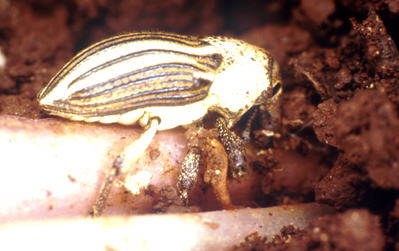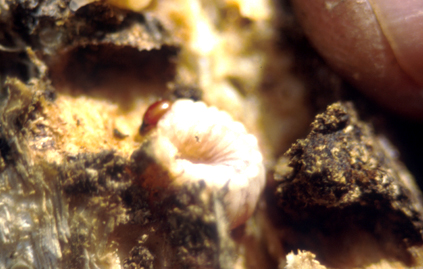|
|
Class
|
Insecta
|
|
Order
|
Coleoptera
|
|
Family
|
Curculionidae
|
A
minor pest.
Tropical
Africa.
The
larvae bore into the stems and sometimes into the storage roots. The stem base
swells up. Adult weevils feed on the outside of the vine and may girdle the stems, causing wilting.
Larva.
The larvae of both species are white, with an orange-brown head capsule, and are
C-shaped.
Pupa.
The pupae are white.
Adult.
A. dentipes is about 1.4 cm long and has conspicuous white longitudinal
stripes along the elytra. Adult A. erroneus is bigger than the former,
and is brownish black with an irregular yellowish patch on each elytron.
Alcidodes
damage is seldom serious, but can discourage farmers who for food security
reasons try to keep their sweetpotato crop in the field for a long period.
The larvae feed inside the vine. Both larvae and pupae
are found inside the vine, mostly near the base. The adults eat their way out of
the vine.
Sweetpotato and groundnut are main hosts, while cotton
and other woody legumes are recorded as alternative hosts.
Larvae and pupae of Alcidodes spp. resemble those
of the more common Cylas spp. which can also develop in vines. However,
the later instars of the Alcidodes larvae and the pupae are much bigger.
Control of this pest is seldom necessary.
Cultural control
Measures
like sufficient rotation, use of clean planting material, sanitation and timely
harvesting are effective in reducing incidence of this pest.
Ames, T., Smit, N.E.J.M., Braun, A.R., O’Sullivan, J.N., and Skoglund, L.G.
1996. Sweetpotato: Major pests diseases, and nutritional disorders.
International Potato Center (CIP). Lima, Perú. 152 p.
Hill, D.S., 1983. Agricultural insect pests of the
tropics and their control - 2nd ed. 472 p.
Contributed
by: Nicole E.J.M. Smit |
Taxonomy
Economic
importance
Geographical
distribution
Damage
Morphology
Biology
and ecology
Host
range
Detection
and inspection
Management
References

Adult
Alcidodes dentipes (N. Smit).

Adult
Alcidodes erroneus in dorsal and lateral view (N. Smit).

Larva of
Alcidodes erroneus (N. Smit) |

